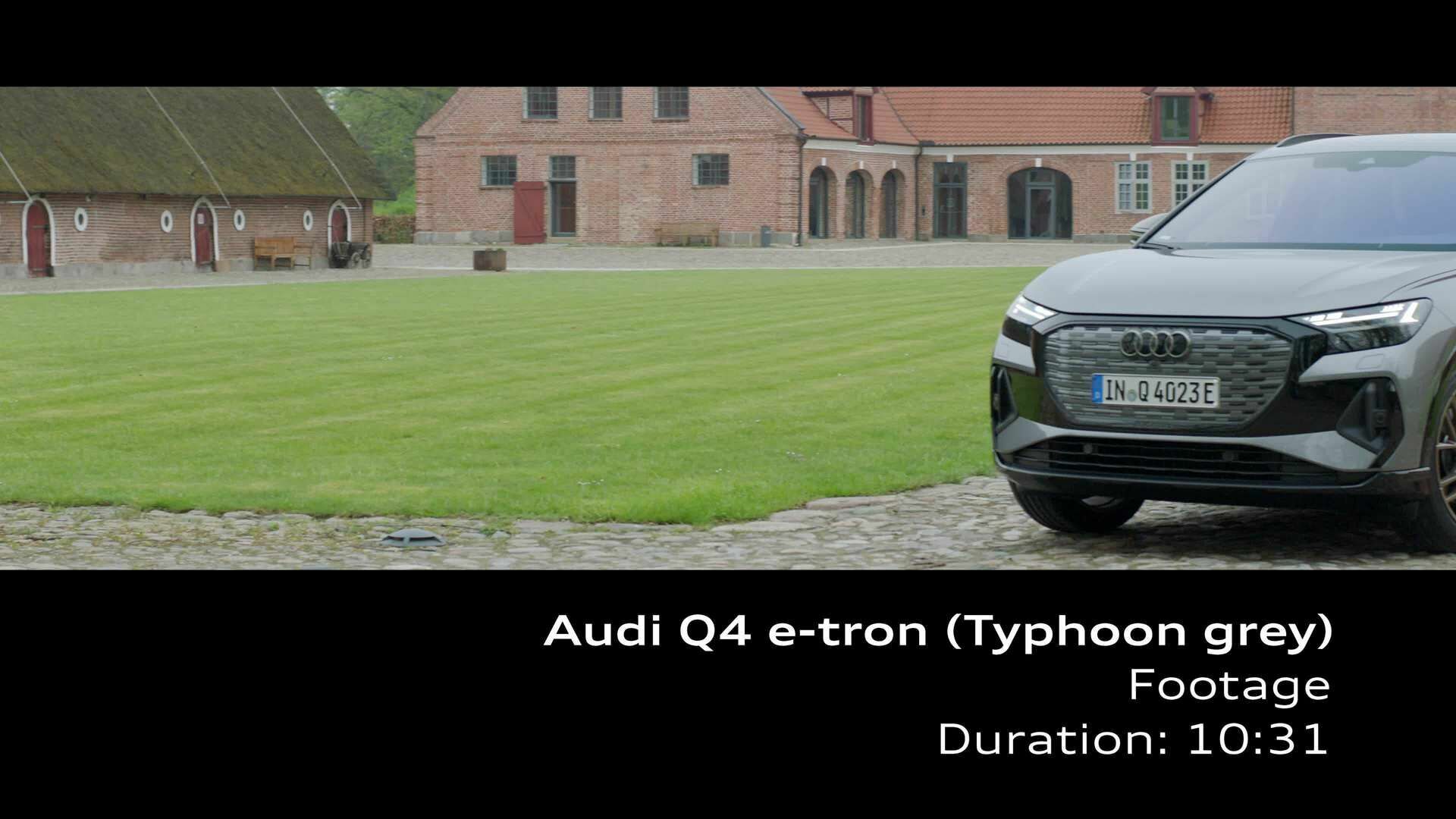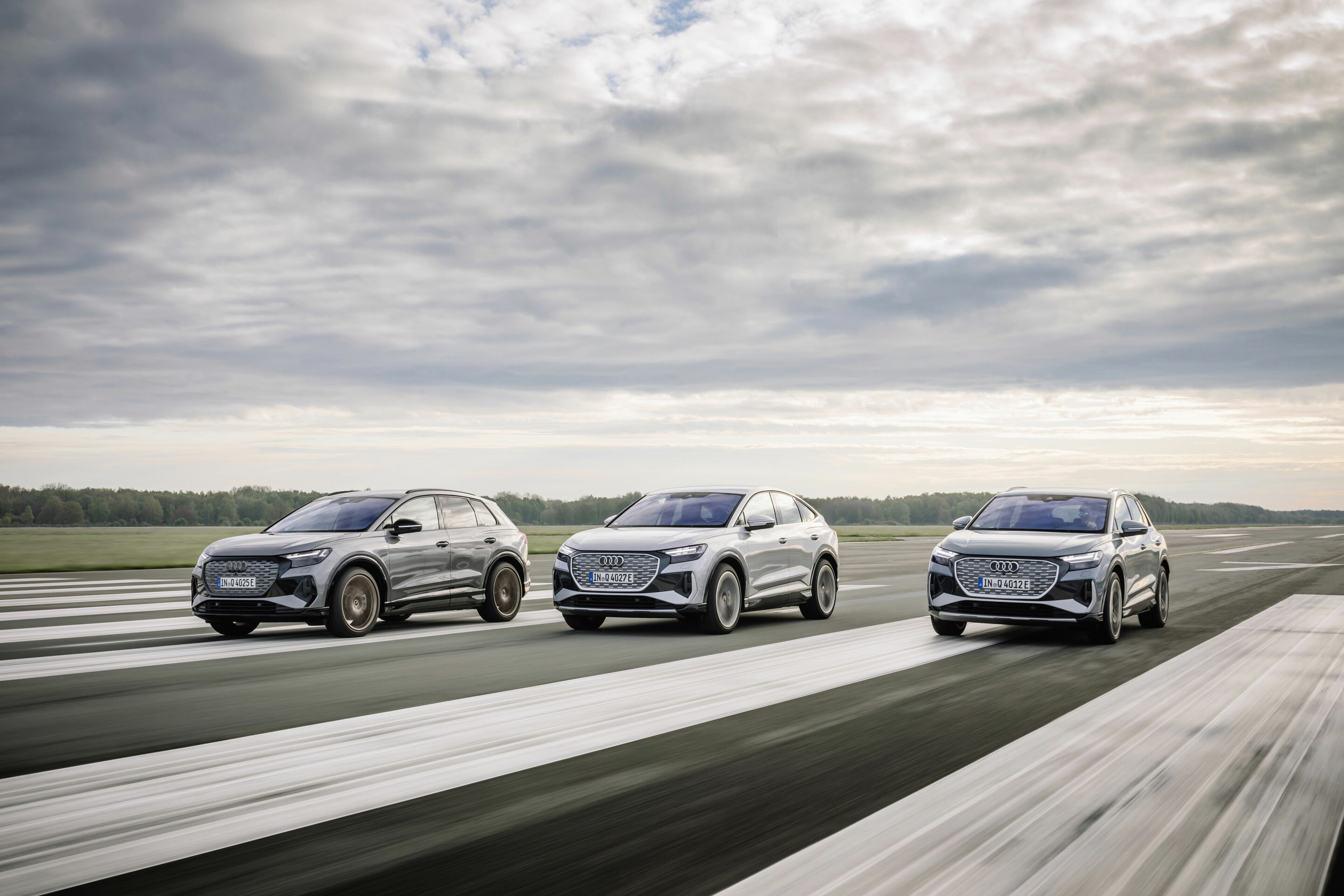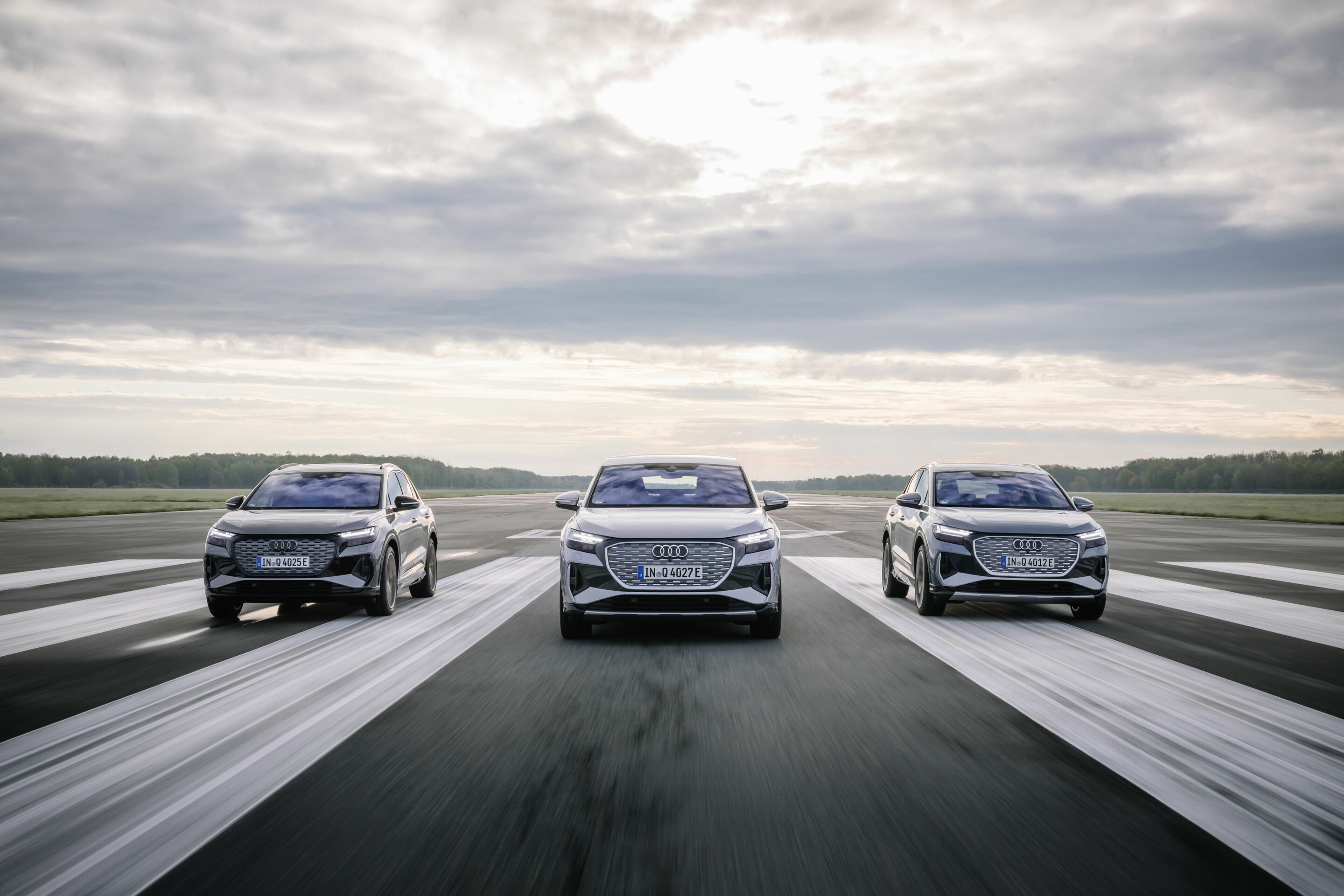Search
All search results for "audi 50"
(646)
 50 years of the Audi five-cylinder
50 years of the Audi five-cylinder
The five-cylinder engine debuted in 1976 in the Audi 100 with 136 PS Successful engine concept for production models and rally sport Signature sound from its unique 1-2-4-5-3 firing order Audi RS 3 2.5 TFSI with 400 PS and 500 Nm torque Hand-assembled at the Bock plant in Győr, Hungary
Audi will celebrate a very special anniversary in 2026: 50 years of the five-cylinder engine. The brand with the four rings first introduced this engine in 1976 in the second-generation Audi 100. This was followed by upgrades and new developments with turbocharging, exhaust gas purification, and four-valve technology, rally engines, and five-cylinder diesel engines. Currently, the 2.5 TFSI in the Audi RS 3 continues the great tradition of five-cylinder engines
Audi’s five-cylinder engines have cult status and are deeply rooted in the Audi DNA. They have played a decisive role in shaping “Vorsprung durch Technik” – on the one hand with numerous successes in motorsport, and on the other, by virtue of their outstanding performance in series production. To this day, the 2.5 TFSI provides a highly evocative driving experience, not least because of its characteristic sound. The HISTORY: 50 years of success in series production and motorsport The first five-cylinder engine powered the Audi 100 (C2) in 1976. Known internally as Type 43, the model was intended to be positioned higher in the market than its predecessor. The four-cylinder engines of the time were not sufficient for the developers’ plans. Audi engineers therefore discussed using inline five-cylinder and six-cylinder engines in the early 1970s. The latter were ruled out due to space constraints and the unfavorable weight distribution. As a result, those responsible opted for the inline five-cylinder engine, which was based on the EA 827 engine concept, still in its infancy at the time. This inline four-cylinder engine was used throughout the Volkswagen Group in the 1970s, including in the Audi 80 and Audi 100.
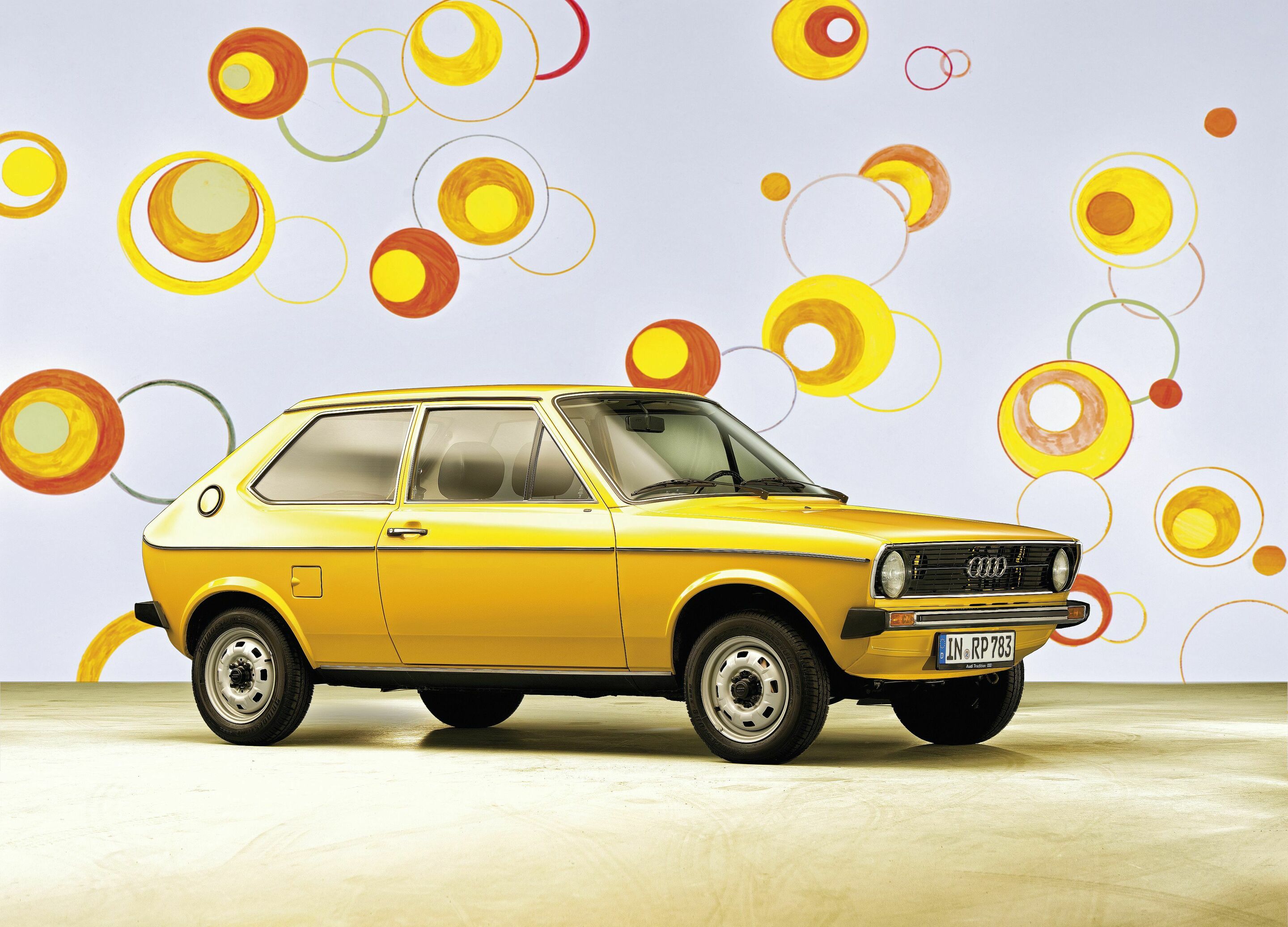 Germany’s first small car was launched 50 years ago: the Audi 50
Germany’s first small car was launched 50 years ago: the Audi 50
The “mini Audi” provided the template for the VW Polo A total of 180,828 Audi 50s were built between 1974 and 1978
It arrived at just the right time: The Audi 50, the first small car from a German manufacturer, was launched in 1974, shortly after the beginning of the oil crisis in 1973. Its fuel consumption was economical, and its design pioneering: front-wheel drive with a transverse engine, a two-door hatchback with a large trunk and fold-down backrest, compact external dimensions, and appealing road performance and driving characteristics. Moreover, the Audi 50 was a blueprint for the structurally almost identical VW Polo, which was launched seven months later, leveraging synergies within the Volkswagen Group – already a recipe for success half a century ago.
It was meant to be modern and versatile, the new Audi 50 – and complete the model range of the Audi 80 and Audi 100 at the bottom end. As early as 1970, the engineers at Audi NSU Auto Union AG started work on the project, spearheaded by CTO Ludwig Kraus. They were looking for a successor to the stalwart NSU small car, which was nearing the end of production. The developers constantly had the following goal: “A contemporary car must be the right size for today’s imperatives,” as stated in the design manifesto for the Audi 50. The key to success was the transverse engine. This allowed the Ingolstadt engineers to fashion a car with a relatively large interior despite its total length of 3.49 meters. Two versions of the “mini Audi,” which weighs just 685 kilograms, were launched: the Audi 50 LS with 50 PS and the Audi 50 GL with 60 PS, both with 1.1-liter engines. The Audi 50 LS had a maximum speed of 142 kph, while the Audi 50 GL maxed out at 152 kph. The 50-PS version used regular gasoline, but the more powerful 60-PS car needed super-gasoline. In 1977, the latter variant was replaced by a newly developed 1,300 cc engine, which ran on ordinary gasoline.
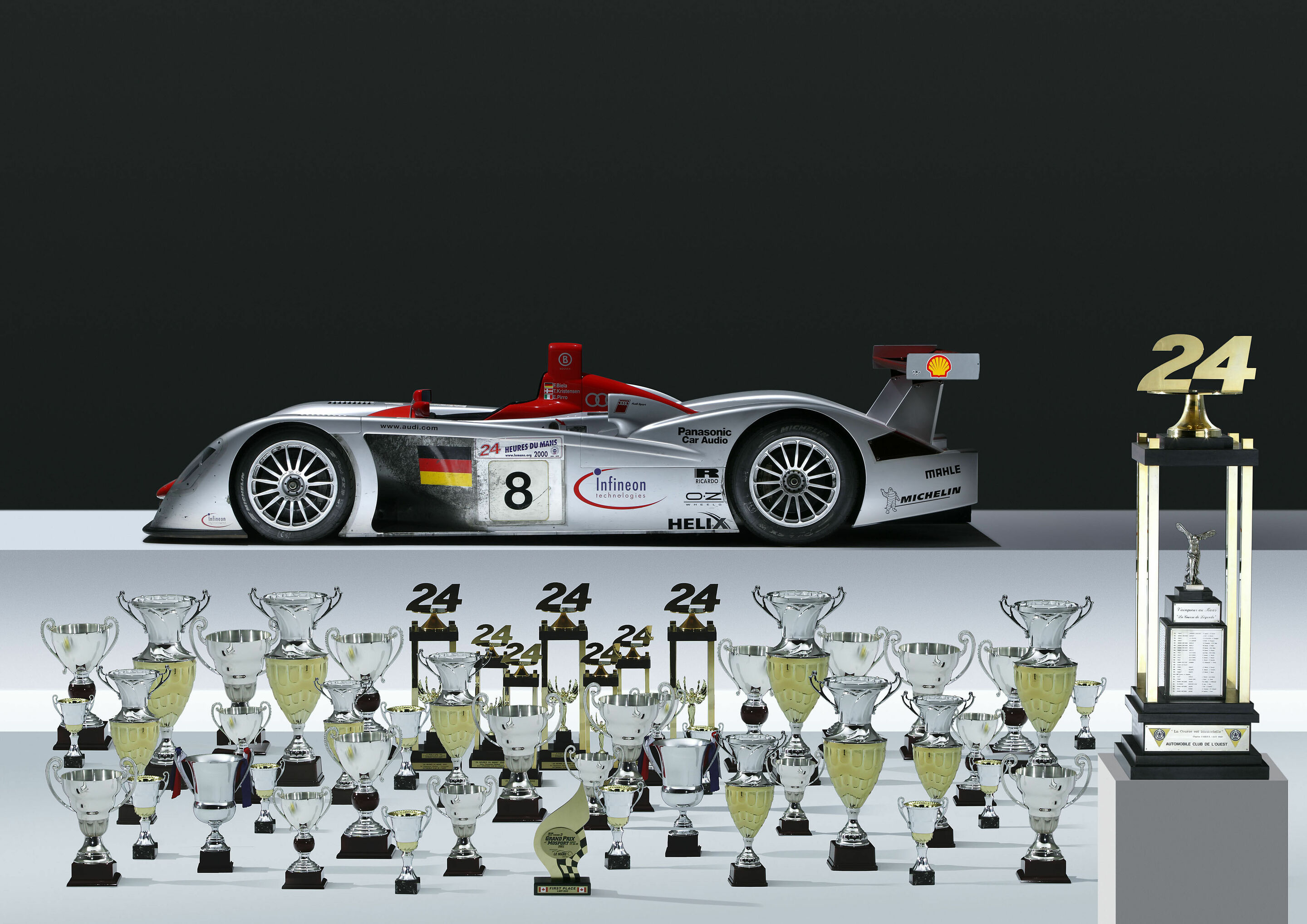 All 50 victories of the Audi R8
All 50 victories of the Audi R8
2001 11 Dallas (USA) Rinaldo Capello / Tom Kristensen 12 Sebring (USA) Laurent Aiello / Michele Alboreto / Rinaldo Capello 13 Donington (GB) Rinaldo Capello / Tom Kristensen 14 Jarama (E) Rinaldo Capello / Tom Kristensen 15 24h Le Mans (F) Frank Biela / Tom Kristensen / Emanuele Pirro 16 Sears Point (USA) Rinaldo Capello / Tom Kristensen 17 Most (CZ) Stefan Johansson / Patrick Lemarie 18 Mosport (CDN) Frank Biela / Emanuele Pirro 19 Laguna Seca (USA) Frank Biela / Emanuele Pirro 20 Petit Le Mans (USA) Frank Biela / Emanuele Pirro 2002 21 Sebring (USA) Rinaldo Capello / Johnny Herbert / Christian Pescatori 22 24h Le Mans (F) Frank Biela / Tom Kristensen / Emanuele Pirro 23 Mid-Ohio (USA) Frank Biela / Emanuele Pirro 24 Road America (USA) Rinaldo Capello / Tom Kristensen 25 Trois-Rivières (CDN) Rinaldo Capello / Tom Kristensen 26 Mosport (CDN) Rinaldo Capello / Tom Kristensen 27 Laguna Seca (USA) Frank Biela / Emanuele Pirro 28 Miami (USA) Frank Biela / Emanuele Pirro 29 Petit Le Mans (USA) Rinaldo Capello / Tom Kristensen 2003 30 Sebring (USA) Frank Biela / Philipp Peter / Marco Werner 31 Road Atlanta (USA) Johnny Herbert / JJ Lehto 32 Trois-Rivières (CDN) Frank Biela / Marco Werner 33 Mosport (CDN) Frank Biela / Marco Werner 34 Road America (USA) Johnny Herbert / JJ Lehto 35 Spa (B) Seiji Ara / Tom Kristensen 36 Laguna Seca (USA) Frank Biela / Marco Werner 37 Miami (USA) Johnny Herbert / JJ Lehto 38 Petit Le Mans (USA) Johnny Herbert / JJ Lehto 39 Le Mans (F) Seiji Ara / Tom Kristensen 2004 40 Sebring (USA) Frank Biela / Pierre Kaffer / Allan McNish 41 Monza (I) Jamie Davies / Johnny Herbert 42 24h Le Mans (F) Seiji Ara / Rinaldo Capello / Tom Kristensen 43 Mid-Ohio (USA) JJ Lehto / Marco Werner 44 Nürburgring (D) Pierre Kaffer / Allan McNish 45 Lime Rock (USA) JJ Lehto / Marco Werner 46 Infineon Raceway (USA) JJ Lehto / Marco Werner 47 Portland (USA) JJ Lehto / Marco Werner 48 Silverstone (GB) Pierre Kaffer / Allan McNish 49 Road America (USA) JJ Lehto / Marco Werner 50
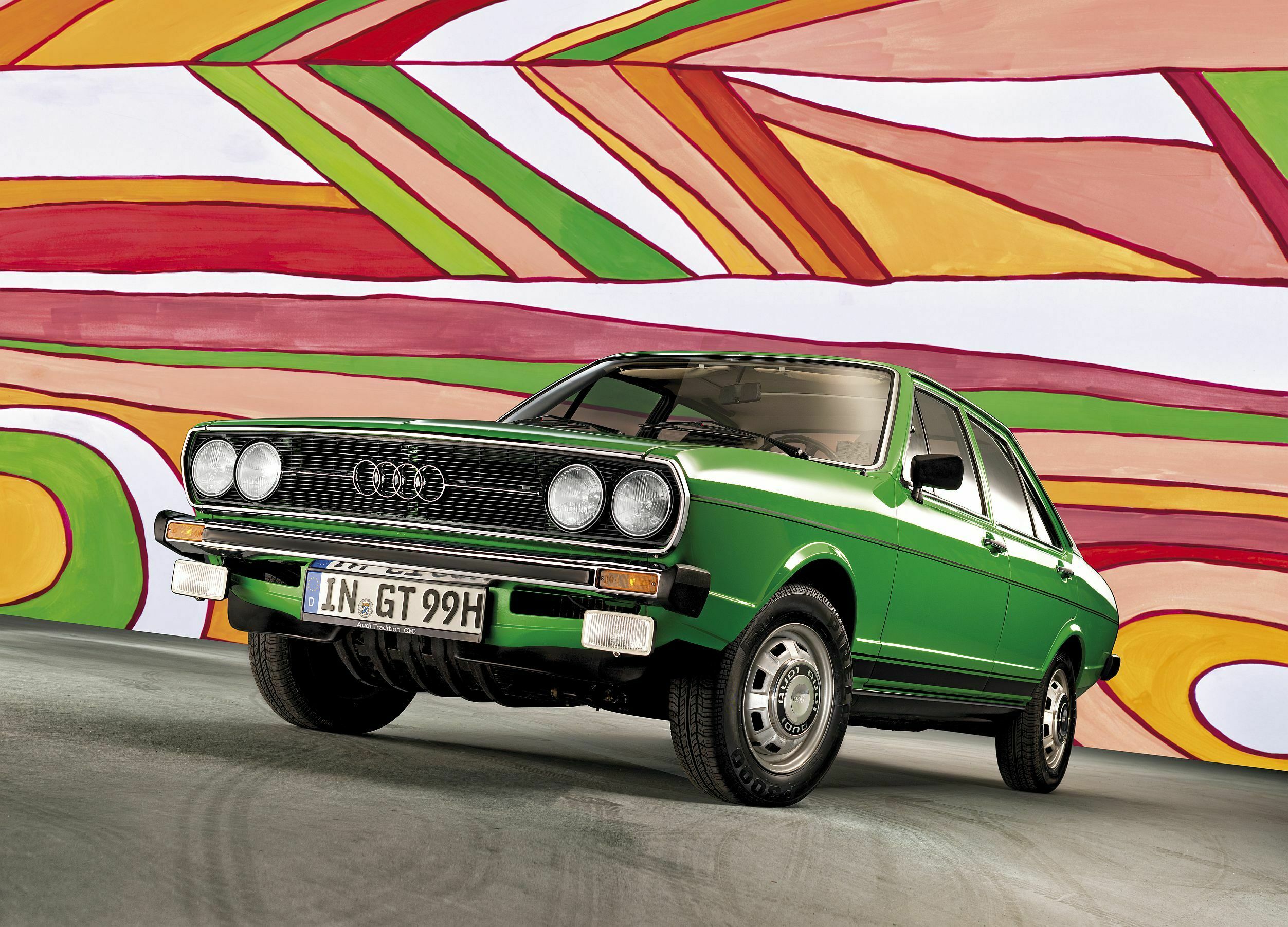 Audi captures the zeitgeist with this car: first Audi 80 unveiled 50 years ago
Audi captures the zeitgeist with this car: first Audi 80 unveiled 50 years ago
1972: Audi 80 is launched and becomes “Car of the Year” Bestseller in series production: More than 12.5 million B1 to B9 (Audi 80 and Audi A4 models) produced to date Oliver Hoffmann, Head of Technical Development: “The Audi 80 shows that Vorsprung durch Technik is a tradition at Audi”
It establishes the B series, is both a pioneer of innovative technology and a trendsetter, and becomes the first million-seller for the brand with the four rings: the Audi 80. The significance of the compact sedan for Audi and the Volkswagen Group is indisputable – not least because the Audi 80 pioneers the modular design.
A bestseller is celebrating its anniversary: With the first Audi 80, known internally as the “B1”, the Ingolstadt-based company hits the bull’s eye in 1972. It is intended to be “modern, but not trendy,” a reliable family car. On this, then Head of Technical Development at Audi Ludwig Kraus and Volkswagen AG, the new parent company, agree in the late 1960s. As in racecar construction, head developer Ludwig Kraus has his employees check every part to see where weight could still be reduced without compromising on long-term quality, solidity, and strength. The extremely lightweight Audi 80, which goes into production 50 years ago, impresses customers with its sporty handling and low consumption, making it, at the start of the 1973 oil crisis, exactly the right car at the right time. Winning “Car of the Year” the same year, the Audi 80 also wins over the international trade press. Oliver Hoffmann, Member of the Board of Management of AUDI AG for Technical Development, still appreciates the achievement of his predecessor Ludwig Kraus and team: “In an impressive way, the Audi 80 demonstrates that Vorsprung durch Technik is a tradition at Audi.” The Audi 80 and its successor models have always been pioneers of major innovation.
 A8 50 TDI quattro tiptronic (210 kW) MHEV
A8 50 TDI quattro tiptronic (210 kW) MHEV
Program for Germany, Status: 10/23/2025 1/2 Audi A8 50 TDI quattro tiptronic 210 kW MHEV Engine / electrics Engine type V6 engine Valve gear / number of valves per cylinder Roller cam follower, overhead camshafts, hydraulic valve-play compensation / 2/2 inlet/exhaust valves per cylinder Displacement in cc / bore x stroke in mm / compression 2967 / 83.0 x 91.4 / 16.3 Max. power output in kW (PS) / at rpm 210 (286) / 3500 - 4000 Max. torque in Nm (lb-ft) / at rpm 600 (442.5) / 1750 - 3250 Mixture preparation Common rail fuel injection system, intercooler Exhaust emission control NOx oxidizing catalytic converter, diesel particulate filter, exhaust gas recirculation, SCR catalytic converter Emission standard Euro 6e-bis Max. electrical output at 12V in kW 3 On-board voltage 1 in volts 12 On-board voltage 2 in volts 48 Drivetrain / transmission Drive type quattro permanent all-wheel drive with self-locking center differential Type of rear axle differential Standard Clutch Hydraulic torque converter with lock-up clutch Transmission type 8-speed tiptronic Transmission ratio in 1st/2nd gear 5.000 / 3.200 Transmission ratio in 3rd/4th gear 2.143 / 1.720 Transmission ratio in 5th/6th gear 1.313 / 1.000 Transmission ratio in 7th/8th gear 0.823 / 0.640 Reverse gear ratio / final drive ratio 1-2 / 2-3 -3.478 / 2.503 / - Suspension / steering / brakes Type and design of front-axle suspension 5-link front axle Type and design of rear-axle suspension 5-link rear axle Tires (basic) 235 / 55 R 18 Wheels (basic) Forged aluminum 8 J x 18 Steering Electromechanical progressive steering with speed-dependent power assistance Steering ratio 15.8 Turning circle in m (ft) 12.5 (41.0) Brake system Dual-circuit brake system with black/white split for front/rear axles; front: aluminum fixed calipers; rear: floating calipers with integrated electronic parking brake Performance / fuel Top speed in km/h (mph) 250 (155.3) (governed) Acceleration, 0-100 km/h (0-62.1 mph) 5.9 Fuel type / octane value
 A8 L 50 TDI quattro tiptronic (210 kW) MHEV
A8 L 50 TDI quattro tiptronic (210 kW) MHEV
Program for Germany, Status: 10/23/2025 1/2 Audi A8 L 50 TDI quattro tiptronic 210 kW MHEV Engine / electrics Engine type V6 engine Valve gear / number of valves per cylinder Roller cam follower, overhead camshafts, hydraulic valve-play compensation / 2/2 inlet/exhaust valves per cylinder Displacement in cc / bore x stroke in mm / compression 2967 / 83.0 x 91.4 / 16.3 Max. power output in kW (PS) / at rpm 210 (286) / 3500 - 4000 Max. torque in Nm (lb-ft) / at rpm 600 (442.5) / 1750 - 3250 Mixture preparation Common rail fuel injection system, intercooler Exhaust emission control NOx oxidizing catalytic converter, diesel particulate filter, exhaust gas recirculation, SCR catalytic converter Emission standard Euro 6e-bis Max. electrical output at 12V in kW 3 On-board voltage 1 in volts 12 On-board voltage 2 in volts 48 Drivetrain / transmission Drive type quattro permanent all-wheel drive with self-locking center differential Type of rear axle differential Standard Clutch Hydraulic torque converter with lock-up clutch Transmission type 8-speed tiptronic Transmission ratio in 1st/2nd gear 5.000 / 3.200 Transmission ratio in 3rd/4th gear 2.143 / 1.720 Transmission ratio in 5th/6th gear 1.313 / 1.000 Transmission ratio in 7th/8th gear 0.823 / 0.640 Reverse gear ratio / final drive ratio 1-2 / 2-3 -3.478 / 2.503 / - Suspension / steering / brakes Type and design of front-axle suspension 5-link front axle Type and design of rear-axle suspension 5-link rear axle Tires (basic) 235 / 55 R 18 Wheels (basic) Forged aluminum 8 J x 18 Steering Electromechanical progressive steering with speed-dependent power assistance Steering ratio 15.8 Turning circle in m (ft) 12.9 (42.3) Brake system Dual-circuit brake system with black/white split for front/rear axles; front: aluminum fixed calipers; rear: floating calipers with integrated electronic parking brake Performance / fuel Top speed in km/h (mph) 250 (155.3) (governed) Acceleration, 0-100 km/h (0-62.1 mph) 5.9 Fuel type / octane value

Audi Q3 Sportback e-hybrid
With an enlarged battery capacity, DC charging capability, and an electric range of up to 118 kilometers, the Audi Q3 Sportback e-hybrid combines comfort and practicality. Its intelligent drive management ensures outstanding efficiency, high regenerative braking performance, and emission-free driving in most day-to-day situations.
Images
Videos
Engine type Inline 4-cylinder engine
Displacement in cc / bore x stroke in mm / compression 1498 / 74.5 x 74.5 / 11.5
Max. power output in kW (PS) / at rpm 130 (177) / 5500 - 6000
Max. torque in Nm (lb-ft) / at rpm 250 (184.4) / 1500 - 4000
Top speed / electrical in km/h (mph) 215 (133.6) (limited) / 140 (87.0)
System acceleration, 0-100 km/h (0-62.1 mph) 6.8
Electrical range, City (EAER) in km (mi) 125 - 141 (77.7 - 87.6)
Electrical range, combined (EAER) in km (mi) 104 - 118 (64.6 - 73.3)
Electric power consumption, weighted combined in kWh/100 km (62.1 mi) 15.1 - 14.0
Fuel consumption, weighted combined in l/100 km (US mpg) 2.2 - 1.7 (106.9 - 138.4)
CO2 emissions, weighted combined, in g/km (g/mi) 50 - 40 (80.5 - 64.4)
CO2 class, weighted combined B
CO2 class with discharged battery E
Unladen weight without driver / with driver / gross weight limit in kg (lb) 1825 / 1900 / 2405 (4023.4 / 4188.8 / 5302.1)
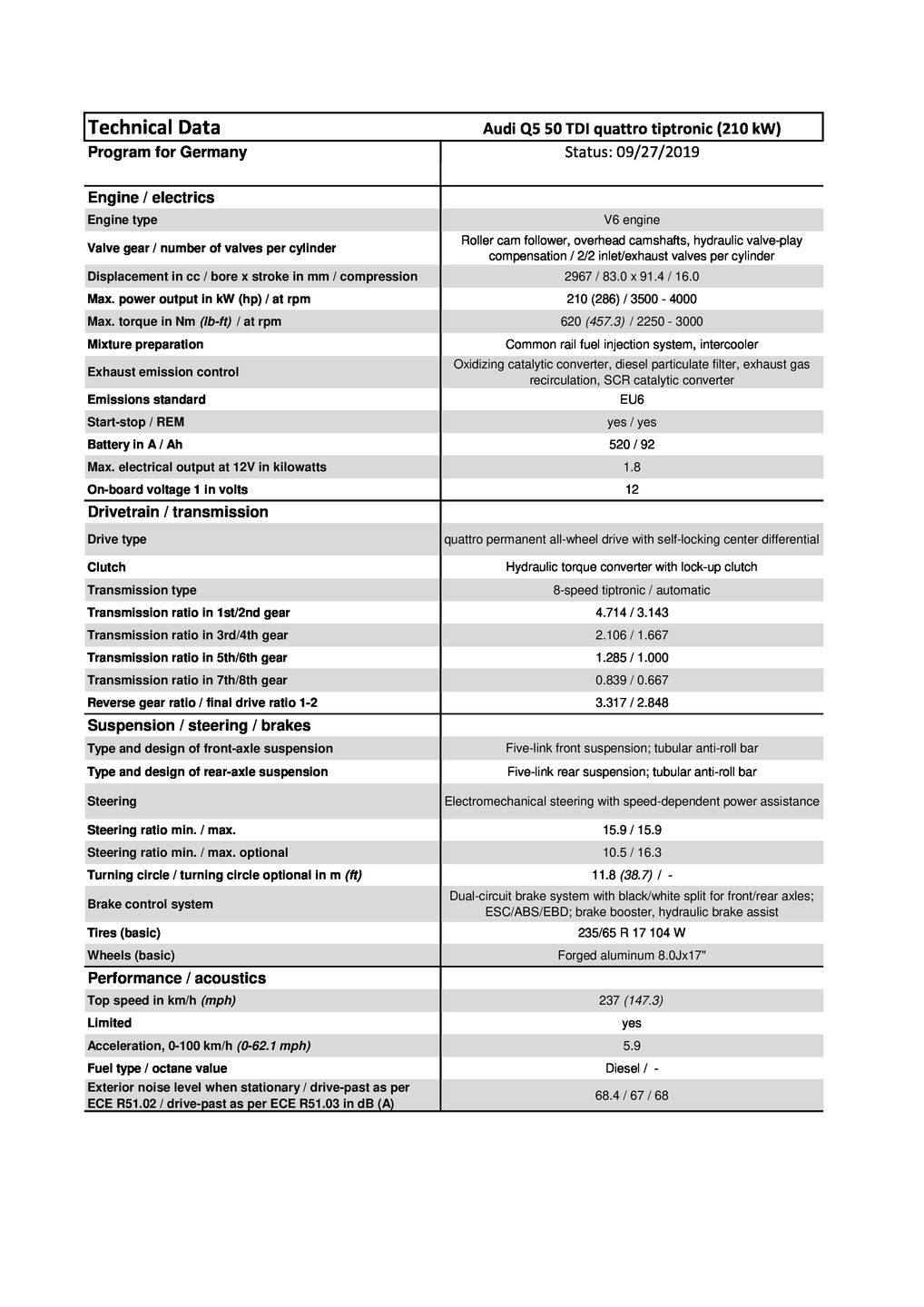 Q5 (2016) 50 TDI quattro tiptronic (210 kW)
Q5 (2016) 50 TDI quattro tiptronic (210 kW)
Technical Data Audi Q5 50 TDI quattro tiptronic (210 kW) Program for Germany Status: 09/27/2019 Engine / electrics Engine type V6 engine Valve gear / number of valves per cylinder Roller cam follower, overhead camshafts, hydraulic valve-play compensation / 2/2 inlet/exhaust valves per cylinder Displacement in cc / bore x stroke in mm / compression 2967 / 83.0 x 91.4 / 16.0 Max. power output in kW (hp) / at rpm 210 (286) / 3500 - 4000 Max. torque in Nm (lb-ft) / at rpm 620 (457.3) / 2250 - 3000 Mixture preparation Common rail fuel injection system, intercooler Exhaust emission control Oxidizing catalytic converter, diesel particulate filter, exhaust gas recirculation, SCR catalytic converter Emissions standard EU6 Start-stop / REM yes / yes Battery in A / Ah 520 / 92 Max. electrical output at 12V in kilowatts 1.8 On-board voltage 1 in volts 12 Drivetrain / transmission Drive type quattro permanent all-wheel drive with self-locking center differential Clutch Hydraulic torque converter with lock-up clutch Transmission type 8-speed tiptronic / automatic Transmission ratio in 1st/2nd gear 4.714 / 3.143 Transmission ratio in 3rd/4th gear 2.106 / 1.667 Transmission ratio in 5th/6th gear 1.285 / 1.000 Transmission ratio in 7th/8th gear 0.839 / 0.667 Reverse gear ratio / final drive ratio 1-2 3.317 / 2.848 Suspension / steering / brakes Type and design of front-axle suspension Five-link front suspension; tubular anti-roll bar Type and design of rear-axle suspension Five-link rear suspension; tubular anti-roll bar Steering Electromechanical steering with speed-dependent power assistance Steering ratio min. / max. 15.9 / 15.9 Steering ratio min. / max. optional 10.5 / 16.3 Turning circle / turning circle optional in m (ft) 11.8 (38.7) / - Brake control system Dual-circuit brake system with black/white split for front/rear axles; ESC/ABS/EBD; brake booster, hydraulic brake assist Tires (basic) 235/65 R 17 104 W Wheels (basic) Forged aluminum 8.0Jx17" Performance / acoustics Top



